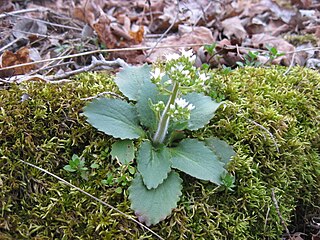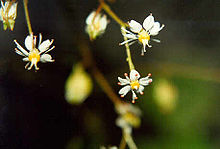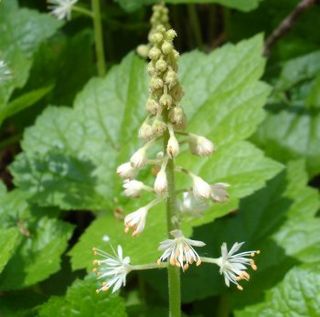
Saxifraga flagellaris, the whiplash saxifrage, is a plant native all over the high arctic and some areas of northern Rocky Mountains, and Norway. It is not very common. It is also known as spider saxifrage or "spider plant", though the latter name more commonly refers to the unrelated Chlorophytum comosum (Agavaceae).

Saxifraga oppositifolia, the purple saxifrage or purple mountain saxifrage, is a species of edible plant that is very common all over the high Arctic and also some high mountainous areas further south, including northern Britain, the Alps and the Rocky Mountains. It is even known to grow on Kaffeklubben Island in north Greenland, at 83°N40°E, the most northerly plant locality in the world.
There are 164 vascular plant species on the Norwegian Arctic archipelago of Svalbard. This figure does not include algae, mosses, and lichens, which are non-vascular plants. For an island so far north, 164 species constitutes an astonishing variety of plant life. Because of the harsh climate and the short growing season, all the plants are slow growing. They seldom grow higher than 10 cm.

Saxifraga cespitosa, the tufted alpine saxifrage or tufted saxifrage, is a flower common to many arctic heights. It appears further south in mountainous areas of the Alps, Norway, Scotland, Wales, Iceland, Siberia, and western North America.

London pride, Saxifraga × urbium, is a perennial garden flowering plant. Alternative names for it include St. Patrick's cabbage, whimsey, prattling Parnell, and look up and kiss me. Before 1700 the “London pride” appellation was given to the Sweet William.

Pimpinella saxifraga, known as burnet-saxifrage, solidstem burnet saxifrage, lesser burnet is a plant of the family Umbelliferae, a native of the British Isles and temperate Europe and Western Asia. It is neither a Burnet, which its leaves resemble, nor a Saxifrage although it has a similar herbal effect as a diuretic.

Saxifraga paniculata is a species of saxifrage native to the United States, Europe and Asia.

Micranthes virginiensis, the early saxifrage, or Virginia saxifrage, is a wildflower native to eastern and central North America. It is a herbaceous plant, which can reach 30 cm (12 in) tall.

Saxifraga aizoides, yellow mountain saxifrage or yellow saxifrage, is a flowering herb and alpine plant of the genus Saxifraga.
Alpine saxifrage is a common name for several different plants and may refer to:
Saxifrage or Saxifraga a plant genus. It may also refer to:

Saxifraga rivularis is a species of saxifrage known by several common names, including highland saxifrage, weak saxifrage, alpine brook saxifrage, and pygmy saxifrage.

Saxifraga aspera is a species of saxifrage known by the common name of rough saxifrage. In German it is known as Rauhhaariger Steinbrech. It is placed in section Trachyphyllum of the genus Saxifraga. There are two subspecies, Saxifraga aspera subsp. aspera and Saxifraga aspera subsp. micrantha. It is a plant of the pan-Arctic tundra and is also found in Europe at moderately high altitudes in the Alps, Pyrenees and northern Apennines.

Saxifraga bryoides is a species of saxifrage known by the common name of mossy saxifrage. In German it is known as Moosartiger Steinbrech. It is an inhabitant of the Arctic tundra but it also grows in the Alps and other European mountain ranges at high altitudes.

Saxifraga hirculus is a species of saxifrage, commonly called marsh saxifrage, yellow marsh saxifrage, or bog saxifrage. It is a perennial herb with yellow flowers and red stem, 5–30 cm high, found on bog landscape.

Saxifraga × arendsi, the mossy saxifrage, is a perennial garden flowering plant.

Micranthes is a genus of flowering plants in the saxifrage family. It was formerly included within the genus Saxifraga until recent DNA evidence showed the members of what is now Micranthes are more closely related to Boykinia and Heuchera than to other members of the genus Saxifraga.

Petrorhagia saxifraga, known as tunic flower or coat flower, is a small, herbaceous flowering plant in the pink family, Caryophyllaceae. It is native to parts of Europe and introduced to the United States and Canada, Great Britain, and Sweden. Petrorhagia saxifraga is also known as tunic saxifrage, pink saxifrage, or just pink.

















